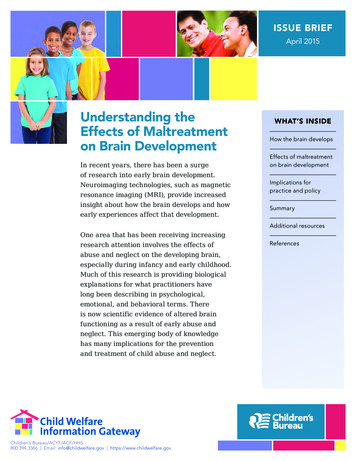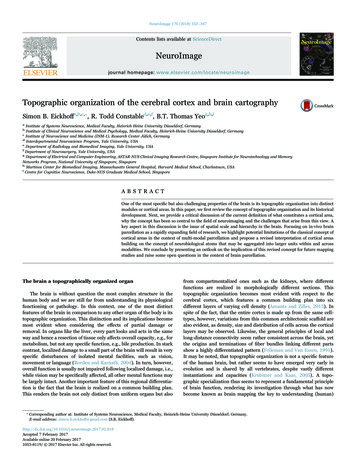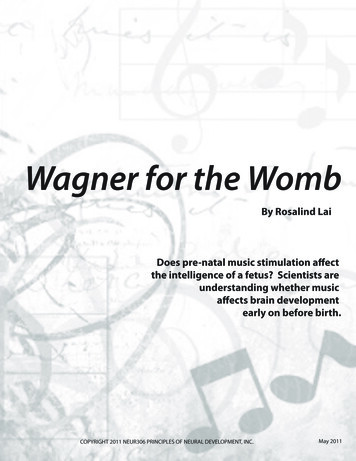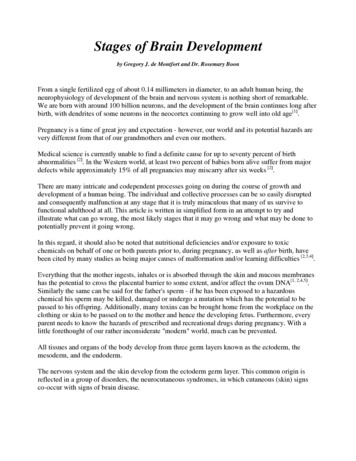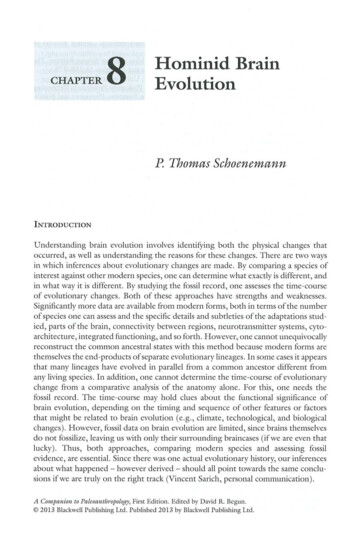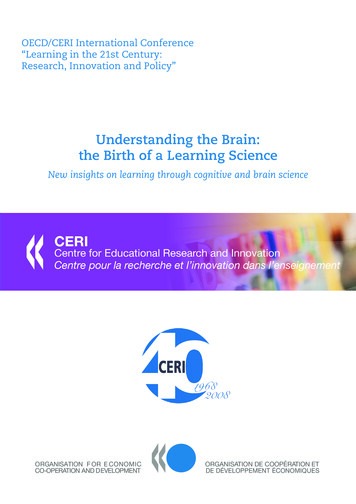
Transcription
OECD/CERI International Conference“Learning in the 21st Century:Research, Innovation and Policy”Understanding the Brain:the Birth of a Learning ScienceNew insights on learning through cognitive and brain scienceORGANISATIONORGANISATIONF ORF ORE CONOMICE VELOPMENTORGANISATIONORGANISATIONDE COOPÉRATIONDE COOPÉRATIONET ETDE QUES
UNDERSTANDING THE BRAIN: THE BIRTH OF A LEARNING SCIENCENEW INSIGHTS ON LEARNING THROUGH COGNITIVE AND BRAIN SCIENCEThe following paper, taken from the recent publication of the same title, provide an overview and bring together the keymessages and potential policy implications, showing how neuroscientific research is already contributing to educationand learning policy and practice. The themes include discussion of lifelong learning; ageing; holistic approaches toeducation; the nature of adolescence; ages for particular forms of learning and the curriculum; addressing the “3 Ds”(dyslexia, dyscalculia, and dementia); and assessment and selection issues in which neuroscience might increasinglybe involved. The chapter also points to areas needing further educational neuroscientific research that have emergedfrom the different chapters of the report.OverviewAfter two decades of pioneering work in brain research, the education community has started torealise that “understanding the brain” can help to open new pathways to improve educational research,policies and practice. This report synthesises progress on the brain informed approach to learning, anduses this to address key issues for the education community. It offers no glib solutions nor does it claimthat brain-based learning is a panacea. It does provide an objective assessment of the current state of theresearch at the intersection of cognitive neuroscience and learning, and maps research and policyimplications for the next decade.Part I “The Learning Brain” is the main report, which is the distillation from all the analyses andevents over the past seven years of the OECD/CERI “Learning Sciences and Brain Research” project. PartII “Collaborative Articles” contains three articles devoted to the “learning brain” in early childhood,adolescence and adulthood, respectively. These have been written, in each case, by three experts who havecombined their experience and knowledge in synergy of the different perspectives of neuroscience andeducation. Annex A reproduces some insights and dialogue that have emerged from the project‟sinteractive website, open to civil society and including notably a teachers‟ forum. Annex B updates thereader with developments in neuroimaging technology which have proved so fundamental to the advancesdiscussed in this report.The first chapter offers a novel “ABC” of the contents of the report by listing and discussingkeywords in alphabetical order. This serves both to give short summaries of complex concepts and to steerthe reader towards the relevant chapter(s) providing the more in-depth coverage. This is followed in thefirst half of the following chapter by a short but essential overview of the brain‟s architecture andfunctioning.How the brain learns throughout lifeNeuroscientists have well established that the brain has a highly robust and well-developed capacityto change in response to environmental demands, a process called plasticity. This involves creating andstrengthening some neuronal connections and weakening or eliminating others. The degree of modificationdepends on the type of learning that takes place, with long-term learning leading to more profoundmodification. It also depends on the period of learning, with infants experiencing extraordinary growth ofnew synapses. But a profound message is that plasticity is a core feature of the brain throughout life.1
There are optimal or “sensitive periods” during which particular types of learning are most effective,despite this lifetime plasticity. For sensory stimuli such as speech sounds, and for certain emotional andcognitive experiences such as language exposure, there are relatively tight and early sensitive periods.Other skills, such as vocabulary acquisition, do not pass through tight sensitive periods and can be learnedequally well at any time over the lifespan.Neuroimaging of adolescents now shows us that the adolescent brain is far from mature, andundergoes extensive structural changes well past puberty. Adolescence is an extremely important period interms of emotional development partly due to a surge of hormones in the brain; the still under-developedpre-frontal cortex among teenagers may be one explanation for their unstable behaviour. We have capturedthis combination of emotional immaturity and high cognitive potential in the phrase “high horsepower,poor steering”.In older adults, fluency or experience with a task can reduce brain activity levels – in one sense this isgreater processing efficiency. But the brain also declines the more we stop using it and with age. Studieshave shown that learning can be an effective way to counteract the reduced functioning of the brain: themore there are opportunities for older and elderly people to continue learning (whether through adulteducation, work or social activities), the higher the chances of deferring the onset or delaying theacceleration of neurodegenerative diseases.The importance of environmentFindings from brain research indicate how nurturing is crucial to the learning process, and arebeginning to provide indication of appropriate learning environments. Many of the environmental factorsconducive to improved brain functioning are everyday matters – the quality of social environment andinteractions, nutrition, physical exercise, and sleep – which may seem too obvious and so easilyoverlooked in their impact on education. By conditioning our minds and bodies correctly, it is possible totake advantage of the brain‟s potential for plasticity and to facilitate the learning process. This calls forholistic approaches which recognise the close interdependence of physical and intellectual well-being andthe close interplay of the emotional and cognitive.In the centre of the brain is the set of structures known as the limbic system, historically called the“emotional brain”. Evidence is now accumulating that our emotions do re-sculpt neural tissue. In situationsof excessive stress or intense fear, social judgment and cognitive performance suffer through compromiseto the neural processes of emotional regulation. Some stress is essential to meet challenges and can lead tobetter cognition and learning, but beyond a certain level it has the opposite effect. Concerning positiveemotions, one of most powerful triggers that motivates people to learn is the illumination that comes withthe grasp of new concepts – the brain responds very well to this. A primary goal of early education shouldbe to ensure that children have this experience of “enlightenment” as early as possible and become awareof just how pleasurable learning can be.Managing one‟s emotions is one of the key skills of being an effective learner; self-regulation is oneof the most important behavioural and emotional skills that children and older people need in their socialenvironments. Emotions direct (or disrupt) psychological processes, such as the ability to focus attention,solve problems, and support relationships. Neuroscience, drawing on cognitive psychology and childdevelopment research, starts to identify critical brain regions whose activity and development are directlyrelated to self-control.2
Language, literacy and the brainThe brain is biologically primed to acquire language right from the very start of life; the process oflanguage acquisition needs the catalyst of experience. There is an inverse relationship between age and theeffectiveness of learning many aspects of language – in general, the younger the age of exposure, the moresuccessful the learning – and neuroscience has started to identify how the brain processes languagedifferently among young children compared with more mature people. This understanding is relevant toeducation policies especially regarding foreign language instruction which often does not begin untiladolescence. Adolescents and adults, of course, can also learn a language anew, but it presents greaterdifficulties.The dual importance in the brain of sounds (phonetics) and of the direct processing of meaning(semantics) can inform the classic debate in teaching reading between the development of specific phoneticskills, sometimes referered to as “syllabic instruction”, and “whole language” text immersion.Understanding how both processes are at work argues for a balanced approach to literacy instruction thatmay target more phonetics or more “whole language” learning, depending on the morphology of thelanguage concerned.Much of the brain circuitry involved in reading is shared across languages but there are somedifferences, where specific aspects of a language call on distinct functions, such as different decoding orword recognition strategies. Within alphabetical languages, the main difference discussed in this report isthe importance of the “depth” of a language‟s orthography: a “deep” language (which maps sounds ontoletters with a wide range of variability) such as English or French contrasts with “shallow”, much more“consistent” languages such as Finnish or Turkish. In these cases, particular brain structures get broughtinto play to support aspects of reading which are distinctive to these particular languages.Dyslexia is widespread and occurs across cultural and socioeconomic boundaries. Atypical corticalfeatures which have been localised in the left hemisphere in regions to the rear of the brain are commonlyassociated with dyslexia, which results in impairment in processing the sound elements of language. Whilethe linguistic consequences of these difficulties are relatively minor (e.g. confusing words which soundalike), the impairment can be much more significant for literacy as mapping phonetic sounds toorthographic symbols is the crux of reading in alphabetic languages. Neuroscience is opening new avenuesof identification and intervention.Numeracy and the brainNumeracy, like literacy, is created in the brain through the synergy of biology and experience. Just ascertain brain structures are designed through evolution for language, there are analogous structures for thequantitative sense. And, also as with language, genetically-defined brain structures alone cannot supportmathematics as they need to be co-ordinated with those supplementary neural circuits not specificallydestined for this task but shaped by experience to do so. Hence, the important role of education – whetherin schools, at home, or in play; and hence, the valuable role for neuroscience in helping address thiseducational challenge.Although the neuroscientific research on numeracy is still in its infancy, the field has already madesignificant progress in the past decade. It shows that even very simple numerical operations are distributedin different parts of the brain and require the co-ordination of multiple structures. The mere representationof numbers involves a complex circuit that brings together sense of magnitude, and visual and verbalrepresentations. Calculation calls on other complex distributed networks, varying according to theoperation in question: subtraction is critically dependent on the inferior parietal circuit, while addition and3
multiplication engage yet others. Research on advanced mathematics is currently sparse, but it seems that itcalls on at least partially distinct circuitry.Understanding the underlying developmental pathways to mathematics from a brain perspective canhelp shape the design of teaching strategies. Different instructional methods lead to the creation of neuralpathways that vary in effectiveness: drill learning, for instance, develops neural pathways that are lesseffective than those developed through strategy learning. Support is growing from neuroscience forteaching strategies which involve learning in rich detail rather than the identification of correct/incorrectresponses. This is broadly consistent with formative assessment.Though the neural underpinnings of dyscalculia – the numerical equivalent of dyslexia – are stillunder-researched, the discovery of biological characteristics associated with specific mathematicsimpairments suggests that mathematics is far from a purely cultural construction: it requires the fullfunctioning and integrity of specific brain structures. It is likely that the deficient neural circuitryunderlying dyscalculia can be addressed through targeted intervention because of the “plasticity” – theflexibility – of the neural circuitries involved in mathematics.Dispelling “neuromyths”Over the past few years, there has been a growing number of misconceptions circulating about thebrain – “neuromyths”. They are relevant to education as many have been developed as ideas about, orapproaches to, how we learn. These misconceptions often have their origins in some element of soundscience, which makes identifying and refuting them the more difficult. As they are incomplete,extrapolated beyond the evidence, or plain false, they need to be dispelled in order to prevent educationrunning into a series of dead-ends.Each “myth” or set of myths is discussed in terms of how they have emerged into popular discourse,and of why they are not sustained by neuroscientific evidence. They are grouped as follows: “There is no time to lose as everything important about the brain is decided by the age of three.” “There are critical periods when certain matters must be taught and learnt.” “But I read somewhere that we only use 10% of our brain anyway.” “I‟m a „left-brain‟, she‟s a „right-brain‟ person.” “Let‟s face it – men and boys just have different brains from women and girls.” “A young child‟s brain can only manage to learn one language at a time.” “Improve your memory!” “Learn while you sleep!”The ethics and organisation of educational neuroscienceThe importance and promise of this new field are not the reason to duck fundamental ethical questionswhich now arise.4
For which purposes and for whom? It is already important to re-think the use and possible abuse ofbrain imaging. How to ensure, for example, that the medical information it gives is kept confidential, andnot handed over to commercial organisations or indeed educational institutions? The more accurately thatbrain imaging allows the identification of specific, formerly “hidden”, aspects of individuals, the more itneeds to be asked how this should be used in education.The use of products affecting the brain: The boundary between medical and non-medical use is notalways clear, and questions arise especially about healthy individuals consuming substances that affect thebrain. Should parents, for instance, have the right to give their children substances to stimulate theirscholarly achievements, with inherent risks and parallels to doping in sport?Brain meets machine: Advances are constantly being made in combining living organs withtechnology. The advantages of such developments are obvious for those with disabilities who are thusenabled, say, to control machines from a distance. That the same technology could be applied to controlindividuals‟ behaviour equally obviously raises profound concerns.An overly scientific approach to education? Neurosciences can importantly inform education but if,say, “good” teachers were to be identified by verifying their impact on students‟ brains, this would be anentirely different scenario. It is one which runs the risk of creating an education system which isexcessively scientific and highly conformist.Though educational neuroscience is still in its early days, it will develop strategically if it is transdisciplinary, serving both the scientific and educational communities, and international in reach. Creating acommon lexicon is one critical step; another is establishing shared methodology. A reciprocal relationshipshould be established between educational practice and research on learning which is analogous to therelationship between medicine and biology, co-creating and sustaining a continuous, bi-directional flow tosupport brain informed educational practice.A number of institutions, networks and initiatives have already been established to show the wayahead. Vignette descriptions of several leading examples are available in this report. They include the JSTRISTEX, Japan Science and Technology‟s Research Institute of Science and Technology for Society;Transfer Centre for Neuroscience and Learning, Ulm, Germany; Learning Lab, Denmark; Centre forNeuroscience in Education: University of Cambridge, United Kingdom; and “Mind, Brain, andEducation”, Harvard Graduate School of Education, United States.Key messages and themes for the futureEducational neuroscience is generating valuable new knowledge to inform educational policy andpractice: On many questions, neuroscience builds on the conclusions of existing knowledge and everydayobservation but its important contribution is in enabling the move from correlation to causation –understanding the mechanisms behind familiar patterns – to help identify effective solutions. On otherquestions, neuroscience is generating new knowledge, thereby opening up new avenues.Brain research provides important neuroscientific evidence to support the broad aim of lifelonglearning: Far from supporting ageist notions that education is the province only of the young – thepowerful learning capacity of young people notwithstanding – neuroscience confirms that learning is alifelong activity and that the more it continues the more effective it is.Neuroscience buttresses support for education‟s wider benefits, especially for ageing populations:Neuroscience provides powerful additional arguments on the “wider benefits” of education (beyond thepurely economic that counts so highly in policy-making) as it is identifying learning interventions as a5
valuable part of the strategy to address the enormous and costly problems of ageing dementia in oursocieties.The need for holistic approaches based on the interdependence of body and mind, the emotional andthe cognitive: Far from the focus on the brain reinforcing an exclusively cognitive, performance-drivenbias, it suggests the need for holistic approaches which recognise the close inter-dependence of physicaland intellectual well-being, and the close interplay of the emotional and cognitive, the analytical and thecreative arts.Understanding adolescence – high horsepower, poor steering: The insights on adolescence areespecially important as this is when so much takes place in an individual‟s educational career, with longlasting consequences. At this time, young people have well-developed cognitive capacity (highhorsepower) but emotional immaturity (poor steering). This cannot imply that important choices shouldsimply be delayed until adulthood, but it does suggest that these choices should not definitively closedoors.Better informing the curriculum and education‟s phases and levels with neuroscientific insights: Themessage is a nuanced one: there are no “critical periods” when learning must take place but there are“sensitive periods” when the individual is particularly primed to engage in specific learning activities(language learning is discussed in detail). The report‟s message of an early strong foundation for lifetimesof learning reinforces the key role of early childhood education and basic schooling.Ensuring neuroscience‟s contribution to major learning challenges, including the “3Ds”: dyslexia,dyscalculia, and dementia. On dyslexia, for instance, its causes were unknown until recently. Now it isunderstood to result primarily from atypical features of the auditory cortex (and possibly, in some cases, ofthe visual cortex) and it is possible to identify these features at a very young age. Early interventions areusually more successful than later interventions, but both are possible.More personalised assessment to improve learning, not to select and exclude: Neuroimagingpotentially offers a powerful additional mechanism on which to identify individuals learning characteristicsand base personalisation; but, at the same time, it may also lead to even more powerful devices forselection and exclusion than are currently available.Key areas are identified as priorities for further educational neuroscientific research, not as anexhaustive agenda but as deriving directly from the report. This agenda for further research – covering thebetter scientific understanding of such matters as the optimal timing for different forms of learning,emotional development and regulation, how specific materials and environments shape learning, and thecontinued analysis of language and mathematics in the brain – would, if realised, be well on the way to thebirth to a trans-disciplinary learning science.This is the aspiration which concludes this report and gives it its title. It is also the report‟s aspirationthat it will be possible to harness the burgeoning knowledge on learning to create an educational systemthat is both personalised to the individual and universally relevant to all.Conclusions and Future ProspectsAfter seven years of a pioneering activity on learning sciences, it would be tempting on the one handto exaggerate the claims that can be made, but also easy to hide behind the plea that further research isneeded before we can reach any conclusions. On the latter, it is certainly true that more research is needed,and some key lines for further research are suggested below. On the former, this concluding chapter largelyabstains from specific recommendations. The field is still too young, and the connections betweenneuroscience and education too complex, for this to be justified. There are few instances where6
neuroscientific findings, however rich intellectually and promising for the future, can be used categoricallyto justify specific recommendations for policy or practice. Indeed, one of the messages from this activity,made already in the 2002 Understanding the Brain – Towards a New Learning Science report, is that weshould beware of simplistic or reductionist approaches, which may grab headlines or offer lucrativeopportunities but which are a distortion of the knowledge base.This chapter brings together the main themes and conclusions from the preceding analysis. It ispossible to put forward some broad propositions or challenges which can open up and refresh the debate onthe future shape and character of our education systems. If we witness the birth of a science of learning,new ideas and evidence will rapidly arise and transform the current landscape. We do not need to wait forthat research; part of CERI‟s mission has always been to help OECD countries think through their futureagendas. The conclusions are at quite a high level of generality, precisely in order to give the necessaryimpetus to carry the discussion across the very broad terrain mapped out in the preceding chapters.Key messages and conclusionsThe most important scientific revolutions all include, as their only common feature, thedethronement of human arrogance from one pedestal after another of previous convictions aboutour centrality in the cosmos.Stephen Jay GouldEducational neuroscience is generating valuable new knowledge to inform educational policy andpracticeThe sweep of this volume – from the learning that takes place in the earliest years of infancy throughto that of the elderly, from knowledge related to specific subject areas through to that concerned withemotions and motivation, from the remedial to the more general understanding of learning – shows howwide-ranging is the contribution that neuroscience can make to educational policy and practice. It hasshown that the contribution of neuroscience to education takes different forms.On many questions, neuroscience builds on the conclusions of existing knowledge from other sources,such as psychological study, classroom observation or achievement surveys. Examples discussed in thisvolume – such as the role of diet to improve educational performance, the turbulence of puberty, or thatconfidence and motivation can be critical to educational success – are not new. But the neuroscientificcontribution is important even for results already known because: It is opening up understanding of “causation” not just “correlation”; and moving importantquestions from the realm of the intuitive or ideological into that of evidence; By revealing the mechanisms through which effects are produced, it can help identify effectiveinterventions and solutions.On other questions, neuroscience is generating new knowledge, opening up new avenues. Withoutunderstanding the brain, for instance, it would not be possible to know the different patterns of brainactivities associated with expert performers compared with novices (as a means to understandingcomprehension and mastery), or how learning can be an effective response to the decline of ageing, or whycertain learning difficulties are apparent in particular students even when they seem to be coping well withother educational demands.7
To these two key contributions can be added a third – that of dispelling neuromyths. Such distortions,discussed in detail in Chapter 6, risk to distract serious educational practice with the faddish, off-the-shelfsolutions of the airport lounge bookshop.Another key set of distinct contributions by neuroscience to education is: Research which is deepening the knowledge base of what constitutes learning as a central aspectof human and social life, and in ways which cut across the different institutional arrangementscalled “education”. Neuroscience is developing the means for revealing hitherto hidden characteristics in individuals,which may be used for remedial purposes – to overcome reading problems or dyscalculia forinstance. Eventually, they may also be used to select or improve performance or exclude, raisinga raft of thorny ethical issues as discussed in Chapter 7. It is, along with other disciplines, able to inform how best to design and arrange differenteducational practices, especially as regards the match between findings on how best learningtakes place and when, on the one hand, and how education is conventionally organised, on theother. It is another question whether that knowledge is being sufficiently acted upon at present.Brain research provides important neurological evidence to support the broad aim of lifelong learningand confirms the wider benefits of learning, especially for ageing populationsOne of the most powerful set of findings concerned with learning concerns the brain‟s remarkableproperties of “plasticity” – to adapt, to grow in relation to experienced needs and practice, and to pruneitself when parts become unnecessary – which continues throughout the lifespan, including far further intoold age than had previously been imagined. The demands made on the individual and on his or her learningare key to the plasticity – the more you learn, the more you can learn. Far from supporting ageist notionsthat education is best concentrated on the young – the powerful learning capacity of young peoplenotwithstanding – neuroscience has shown that learning is a lifelong activity and that the more that itcontinues the more effective it is.As the demands for having an evidence-base on which to ground policy and practice grow, so has itbecome even more important to broaden the understanding of the “wider benefits” of education beyond theeconomic criteria which so often dominate policy cost-benefit analyses. There is growing evidence to showfor instance that educational participation can have powerful benefits in terms of health or civicparticipation (see also CERI work on the “Social Outcomes of Learning”). This report has underpinned thearguments about the wider benefits of learning: the enormous and costly problems represented by seniledementia in ever-ageing populations can be addressed through the learning interventions being identifiedthrough neuroscience.Combinations of improved diagnostics, opportunities to exercise, appropriate and validatedpharmacological treatment, and good educational intervention can do much to maintain positive well-beingand to prevent deterioration.We need holistic approaches based on the interdependence of body and mind, the emotional and thecognitiveWith such a strong focus on cognitive performance – in countries and internationally – there is therisk of developing a narrow understanding of what education is for. Far from the focus on the brainreinforcing an exclusively cognitive, performance-driven bias, it actually suggests the need for holistic8
approaches which recognise the close interdependence of physical and intellectual well-being, and theclose interplay of the emotional and cognitive, the analytical and the creative arts.The ways in which the benefits of good diet, exercise, and sleep impact on learning are increasinglyunderstood through their effects in the brain. For older people, cognitive engagement (such as playingchess or doing crossword puzzles), regular physical exercise, and an active social life promote learning andcan delay degeneration of the ageing brain (see Chapter 2).The analysis of this report shows not only how emotions play a key part in the functioning of thebrain, but the processes whereby the emotions affect all the others. Especially important for educationalpurposes is the analysis of fear and stress, which shows how they, for instance, reduce analytical capacity,and vice versa how positive emotions open doors within the brain.This is just as relevant for the adult student confronted by an uncomfortable return to education as itdoes for the young person confronted by the unfamiliar demands of s
The dual importance in the brain of sounds (phonetics) and of the direct processing of meaning (semantics) can inform the classic debate in teaching reading between the development of specific phonetic skills







